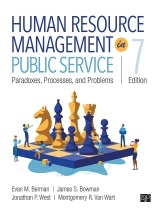Human Resource Management in Public Service: Paradoxes, Processes, and Problems offers provocative and thorough coverage of the complex issues faced by employees and managers in the public sector, including managing under tight budgets with increasing costs, hiring freezes, contracting out, and the politicization of the civil service. Continuing the award-winning tradition of previous editions, authors Evan M. Berman, James S. Bowman, Jonathan P. West, and Montgomery R. Van Wart encourage active learning through various skill-building exercises and a mixture of individual, group, and in-class tasks.
The Seventh Edition includes new examples on how COVID-19 has disrupted the workplace, equity and racial discord, organizational diversity, employee engagement and motivation, leadership development training, work-life balance, gender-based inequities, behavioral biases in appraisal, and unionization trends.
Jadual kandungan
Preface
Acknowledgments
Introduction
PART I • CONTEXT AND CHALLENGES
CHAPTER 1 • The Public Service Heritage: People, Process, and Purpose
A Day in the Life of Maria Hernandez
Some Challenges in Getting and Managing the Right People
Some Basic Definitions
The Structure and Role of Human Resource Departments
Historical and Institutional Context
Reforming Government in the Clinton, Bush, Obama, and Trump Years
Human Resource Management Principles
Ethics and Moral Management
CHAPTER 2 • Legal Rights and Responsibilities: Laws Governing the Workplace
The Foundations of Employment Law
The Employment Relationship
Balancing Employer, Employee, and Societal Interests
Privacy Issues
Pre-employment Investigations: Truth, Personality, Health, Credit, and Criminal Records
Discrimination
PART II • PROCESSES AND SKILLS: FROM START TO FINISH
CHAPTER 3 • Recruitment: From Passive Posting to Social Media Networking
Factors in Recruitment: Employer and Applicant Perspectives
Recruitment Steps
Planning and Approval
Position Announcements
Recruitment Strategies
Enhancing Recruitment Prospects: The Seeker’s Perspective
Advancing From Job Seeking to Career Development
CHAPTER 4 • Selection: From Civil Service Commissions to Decentralized Decision Making
The Bases and Origin of Selection
Criteria in Selecting Selection Tests
Selection: Four Screening Phases
Initial Reviewing and Testing
Interviewing and Reference Checks: Narrowing the Pool
General Considerations for Those Conducting Interviews
Choosing and Negotiation
Post-offer and Hiring Issues
Appendix: The Professional Commitment Statement for Job Seekers
CHAPTER 5 • Position Management: Judicious Plan or Jigsaw Puzzle?
Three Types of Personnel Strategies
The Origins of Position Classification and Management
Job Design and Job Analysis
Job and Position Descriptions
From Jobs to Job Systems
Curbing, Cutting, and Eliminating Workforce
CHAPTER 6 • Employee Motivation: Possible, Probable, or Impossible?
Pull, Push, or Drive?
Human Resource Management and the Climate for Motivation
Tools of Motivation
CHAPTER 7 • Compensation: Vital, Visible, and Vicious
Equity and Expectancy Theory
Pay Determination
Philosophy: Lead, Match, or Lag
The Perennial Pay Debate
Labor Market Forces: External Competition
Job Content: Internal Consistency
Individual Considerations: Fairness and Contributions
Implications
Appendix: Compensation for Graduate Degrees in Public Affairs and Administration
CHAPTER 8 • Employee-Friendly Policies: Fashionable, Flexible, and Fickle
Workforce and Workplace Trends
Work–Family Programs
Health, Safety, and Wellness Programs
Flexible Work Arrangements
Traditional Benefits: Not-So-Employee-Friendly Trends
Implementation, Assessment, and Evaluation
Avoiding and Coping With Hostility at Work
Best Places to Work
Appendix A: Questions for Employees and Employers Regarding Telecommuting Arrangements
Appendix B: Some Questions to Answer When Considering Implementation of Employee-Friendly Policies
Appendix C: Family-Friendly Policies
CHAPTER 9 • Training and Development: Exploring New Frontiers
General Principles of Learning
Training Strategies
Organizational Training and Development
The Strategic Turn
Application: Ethics Training
Appendix: Needs Assessment and Evaluation for Training
CHAPTER 10 • Appraisal: A Process in Search of a Technique
Evolution
Appraisal Systems
Raters
Rating Errors: The Underbelly of Appraisals
Improving the Process
Disciplinary Systems
Appendix: Corrective Actions
CHAPTER 11 • Unions and the Government: Protectors, Partners, and Punishers
Background: The Context and Evolution of Employee Relations
Differing Views of Unions
Paradoxes and Contradictions
Trends and Variations
Appendix A: Tips for Managers When Dealing With Unions
Appendix B: Tips for Unions When Dealing With Managers
CHAPTER 12 • Collective Bargaining: Structures, Strategies, and Skills
Structure, Representation, and Collective Bargaining
Bargaining-Related Reforms
Hostility vs. Harmony
Appendix A: Bargaining Checklist and Observation Sheet
Appendix B: Mock Disciplinary Appeal Board Hearing
CONCLUSION • The Future as Opportunity, Not Destiny
New Technologies, Human Competencies, Failures, and Reforms
Taking Responsibility for Paradoxes
Public Service as a Calling
The Years Ahead
Envoi: Dream While Awake
Glossary
Index
About the Authors
Mengenai Pengarang
Montgomery Van Wart is a professor at California State University San Bernardino and a visiting professor at the University of Hong Kong. His publications include nine books and a substantial number of articles in the leading journals in his field. His most recent book is Leadership and Culture: Comparative Models of Top Civil Servant Training, with Hondeghem and Schwella (Palgrave Macmillan, 2015). His research areas are administrative leadership, human resource management, training and development, administrative values and ethics, organization behavior, and general management. He also serves on numerous editorial boards and as the Associate Editor for Public Productivity & Management Review. As an instructor, he has spent as much time teaching and facilitating programs for executives and managers in public agencies as he has teaching graduate students. His training programs have been for individuals in all levels of government in the United States and executives and elected officials from foreign countries.












